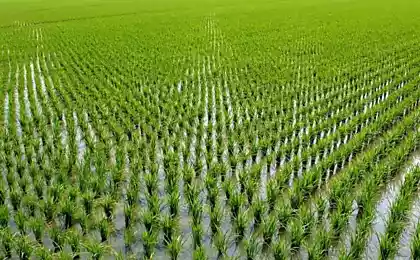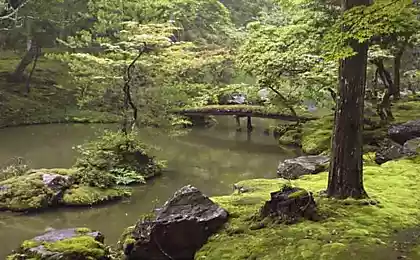783
Interesting facts about the Japanese rice
There are things to explain that too - easier to show something. Look at these two characters: 御 飯. In Japanese, they play exactly the same role as in Russian - corn, indicating unmilled wheat or rye grain and derived from the word "live." A "Gohan" - is cooked rice. Exactly the same characters denoted any food. The value of rice in the Japanese life very clear.
Will be 11 photos + text.
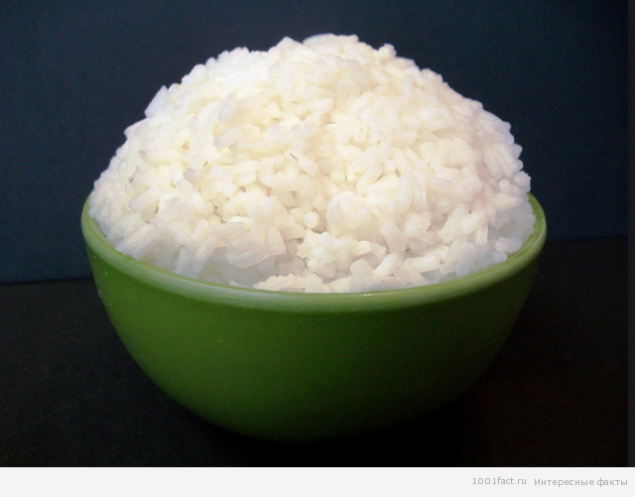
Rice field to the people of Japan - that of wheat for residents of Russia, Ukraine or Belarus. There is, perhaps, not a single corner of the country, where it had not turned green rice field, giving the landscape a special color area. How many poems, songs, paintings and other works of art devoted to light-green shoots of rice in the water up to his ankles!

Until recent decades, peasant labor rice cultivation was severe and harmful to health, but necessary. Now Japan's agricultural sector employs only 5% of the population. But these five percent, armed with modern technology exclusively local production, provide on the table for half of all Japanese fruit, almost nine-tenths of all the vegetables. And absolutely - rice!

Rice appeared on the Japanese islands, along with settlers moving from South-East Asia, the Korean peninsula and Taiwan. Rice crops in Japan and more than two thousand years. And that led to the final figure of the then population of transition to a sedentary lifestyle. And at first the Japanese ate brown rice - it is simply roasted over a fire. Art purification of rice from the husk they possessed not immediately ...

It is interesting to look rice fields with the first sprouts. Above shoots continuously moving turntable installed to deter birds. Often bounds decorates a special doll Kakashi, like our bogey; Its mission - to deter pests. In the field close to the village, or put a stone statue of a "god" or "spirit" of the field, but Hatake kamisama; his characteristic phallic shape, and it is decorated with symbols of fertility.
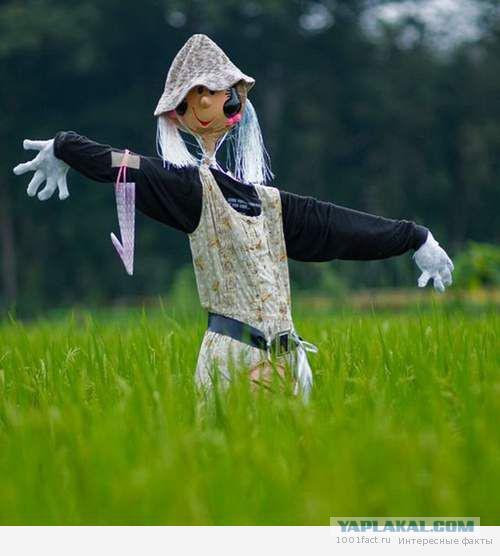
Japanese rice special, quite unlike the Russian or Indian. Snow-white oval grain of rice when cooking does not fall apart and keeps its original shape, simultaneously highlighting the adhesive.
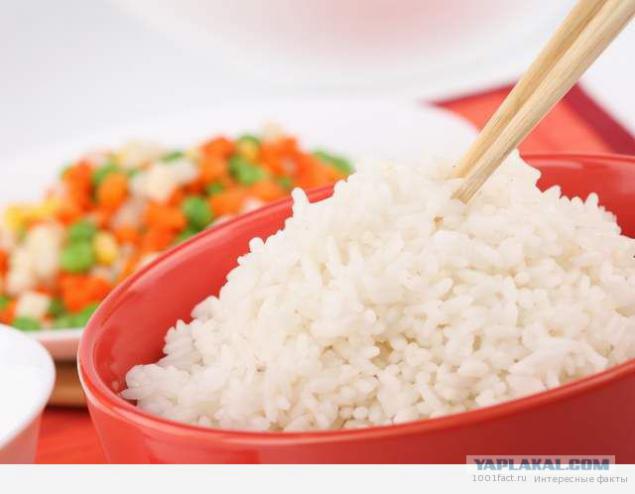
This gluten and adheres to one grain to another. How else do you think could be blind and rice bun o-nigiri and famous all over the culinary world of sushi?

The cost of the cheapest rice variety in Japan - about ¥ 500 per kilogram (over 160 rubles). To put it mildly, is expensive. But the Japanese are buying rice never save because they find it a good basis for the table. Try to buy the best quality of its kind. The standard package of Japanese rice in the Japanese eats 2 kg less than a week - because rice is a part of many dishes.

Each package is written that in the variety of rice in it, where and in what month is grown, what its properties. The Japanese have their own preferences with regards to places of rice cultivation. The most popular of its varieties are grown in Niigata Prefecture - it is deservedly called the "rice place" in Japan. Well, among the most favorite varieties Niigata - kosihikari.

Rice is grown all over Japan, it's true. But in a country of more than three-quarters of the territory occupied by hills and mountains. Therefore, rice acreage does not exceed 13% of the fertile land of Japan. And when the case of lowering the average temperature on the island descend typhoons and rice yield is low, the food crisis is happening. In this case, rice is imported to Japan from India and Thailand. Taste had a very different, and for the preparation of traditional Japanese dishes he does not fit perfectly.

The Russian will be very surprised to learn that he had come to his country the Japanese took a supply of rice. After all, you can buy in any grocery store! But the peculiarity of Japanese rice is that it can be used as a separate dish; we, unfortunately, is suitable only as a garnish. But the attitude of Japanese rice to the Russian citizen, brought up on caring for the bread, perfectly understandable. The Japanese certainly eat up all the rice to the last seed - not to offend neither the rice nor the owner of the table.
1001fact.ru/2014/01/interesnye-fakt...yaponskom-rise/

Source:
Will be 11 photos + text.

Rice field to the people of Japan - that of wheat for residents of Russia, Ukraine or Belarus. There is, perhaps, not a single corner of the country, where it had not turned green rice field, giving the landscape a special color area. How many poems, songs, paintings and other works of art devoted to light-green shoots of rice in the water up to his ankles!

Until recent decades, peasant labor rice cultivation was severe and harmful to health, but necessary. Now Japan's agricultural sector employs only 5% of the population. But these five percent, armed with modern technology exclusively local production, provide on the table for half of all Japanese fruit, almost nine-tenths of all the vegetables. And absolutely - rice!

Rice appeared on the Japanese islands, along with settlers moving from South-East Asia, the Korean peninsula and Taiwan. Rice crops in Japan and more than two thousand years. And that led to the final figure of the then population of transition to a sedentary lifestyle. And at first the Japanese ate brown rice - it is simply roasted over a fire. Art purification of rice from the husk they possessed not immediately ...

It is interesting to look rice fields with the first sprouts. Above shoots continuously moving turntable installed to deter birds. Often bounds decorates a special doll Kakashi, like our bogey; Its mission - to deter pests. In the field close to the village, or put a stone statue of a "god" or "spirit" of the field, but Hatake kamisama; his characteristic phallic shape, and it is decorated with symbols of fertility.

Japanese rice special, quite unlike the Russian or Indian. Snow-white oval grain of rice when cooking does not fall apart and keeps its original shape, simultaneously highlighting the adhesive.

This gluten and adheres to one grain to another. How else do you think could be blind and rice bun o-nigiri and famous all over the culinary world of sushi?

The cost of the cheapest rice variety in Japan - about ¥ 500 per kilogram (over 160 rubles). To put it mildly, is expensive. But the Japanese are buying rice never save because they find it a good basis for the table. Try to buy the best quality of its kind. The standard package of Japanese rice in the Japanese eats 2 kg less than a week - because rice is a part of many dishes.

Each package is written that in the variety of rice in it, where and in what month is grown, what its properties. The Japanese have their own preferences with regards to places of rice cultivation. The most popular of its varieties are grown in Niigata Prefecture - it is deservedly called the "rice place" in Japan. Well, among the most favorite varieties Niigata - kosihikari.

Rice is grown all over Japan, it's true. But in a country of more than three-quarters of the territory occupied by hills and mountains. Therefore, rice acreage does not exceed 13% of the fertile land of Japan. And when the case of lowering the average temperature on the island descend typhoons and rice yield is low, the food crisis is happening. In this case, rice is imported to Japan from India and Thailand. Taste had a very different, and for the preparation of traditional Japanese dishes he does not fit perfectly.

The Russian will be very surprised to learn that he had come to his country the Japanese took a supply of rice. After all, you can buy in any grocery store! But the peculiarity of Japanese rice is that it can be used as a separate dish; we, unfortunately, is suitable only as a garnish. But the attitude of Japanese rice to the Russian citizen, brought up on caring for the bread, perfectly understandable. The Japanese certainly eat up all the rice to the last seed - not to offend neither the rice nor the owner of the table.
1001fact.ru/2014/01/interesnye-fakt...yaponskom-rise/

Source:


